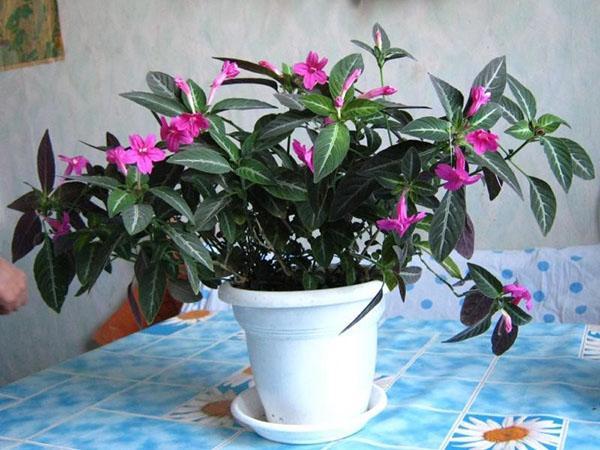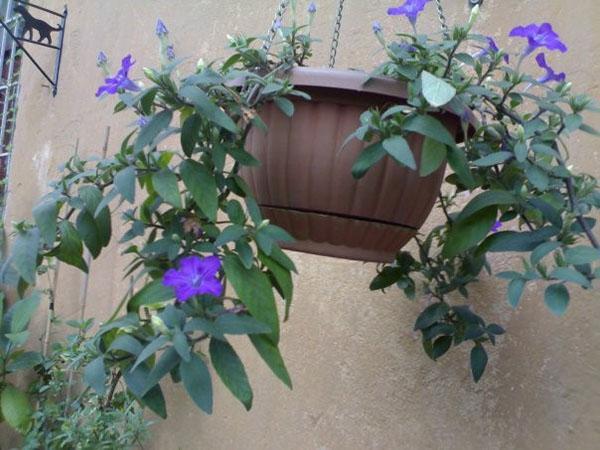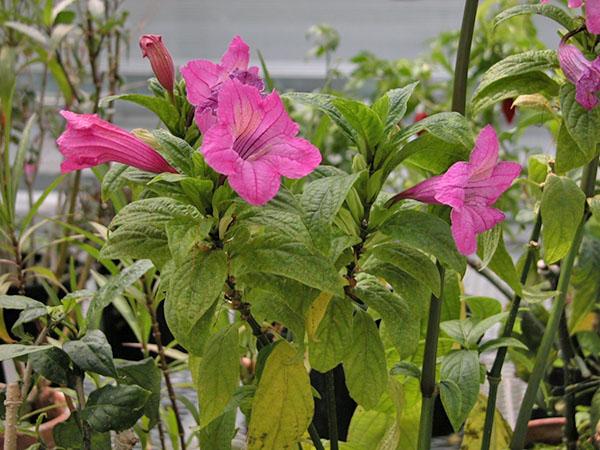Home care for ruella for lush bloom
 Among the many indoor plants, ruelia is in incredible demand. Caring for ruella at home is very simple.It is an incredibly beautiful plant with bright buds of different shades.
Among the many indoor plants, ruelia is in incredible demand. Caring for ruella at home is very simple.It is an incredibly beautiful plant with bright buds of different shades.
Ruellia: plant description

Popular types of flower:
- Ruellia large-flowered. Differs in erect, tall shoots that branch out. The flowers are large in size and look like a bell. In length, the opened buds reach 10 cm, and in width about 8 cm.The petals have a pink-purple hue. You can observe flowering in late autumn or winter.

- Ruella Portella. This flower is native to the rainforests of South America. Externally, the plant is very similar to blue ruella. The leaves are large, brown-colored. It blooms with a deep pink tint.

- Ruelle Britonne. This is a shrub that does not exceed 1 m in height. The flower reaches such sizes due to the fact that the stems become woody closer to the base. If you provide this species with the right lighting, then the leaves will be wide and rich green with a pleasant bluish tint. The flowers of Britonne's ruella are purple, rather large.

- Ruellia Blue or Devos. The homeland is the rainforests of Brazil. The stem is grayish, slightly pubescent. It grows to a height of about 40 cm. The leaves are elongated, slightly velvety. From above they are emerald, and from below they have a purple hue. The buds are medium in size. They can be white or lilac, less often with purple stripes.

- Ruellia Karolinska. The plant is distinguished by long knotty, bare shoots. Leaves of classic shape, slightly pointed at the end. They all have a dark green tint. The buds are large enough. When loose, their diameter reaches 5 cm. The petals are blue with a purple tint.

Caring for ruella at home
 In order for a flower to decorate a room for a long time, you need to follow simple rules. These include watering, feeding, choosing a place, lighting.
In order for a flower to decorate a room for a long time, you need to follow simple rules. These include watering, feeding, choosing a place, lighting.
Lighting
Ruella loves a lot of diffused light. In order for the flower to always have a beautiful appearance, the flowerpot must be placed on the windowsillsthat face the west or east side. It is not recommended to grow a bush in the northern part of the room, since a lack of light will negatively affect its development. If the flowerpot is kept on the south window, then at lunchtime it must be shaded. Ignoring this rule can lead to burns on the leaves.
Flower irrigation
 Watering should be done as the soil dries. The flower does not tolerate excess moisture. Therefore, in order not to harm it, it is necessary to carry out the procedure only after the topsoil has dried.
Watering should be done as the soil dries. The flower does not tolerate excess moisture. Therefore, in order not to harm it, it is necessary to carry out the procedure only after the topsoil has dried.
Water for irrigation should be used separated, without any impurities. It should be warm enough, as cold liquid can lead to disease.
Air temperature
It is best to keep the flower in a room where the thermometer readings are within +25 ° C. In winter, the temperature should be lowered to +18 ° C. Also, do not forget about airing the room.
With improper air circulation, the shoots may begin to rot, and the leaves may become covered with powdery mildew.
The choice of soil for replanting
 Ruella primer can be purchased at any specialty store. It is best to give preference to universal types. Also, the substrate can be prepared at home. To do this, in equal quantities, you need to use sod land, deciduous soil, sand and humus. It will be good to put a little in the resulting mixture vermiculite... It will replace drainage.
Ruella primer can be purchased at any specialty store. It is best to give preference to universal types. Also, the substrate can be prepared at home. To do this, in equal quantities, you need to use sod land, deciduous soil, sand and humus. It will be good to put a little in the resulting mixture vermiculite... It will replace drainage.
Fertilizing a flower
Like all houseplants, ruella loves feeding. It is necessary to bring the mixture in summer, autumn and during the flowering period of the bushes. Mineral preparations are used for these purposes. They must be introduced in liquid form 2 times a month.
Pruning rules
If you want the flower to branch well and develop quickly, you need to pinch it regularly. All stems from which the leaves have fallen must be removed. Thus, young shoots will appear in their place. The procedure should be carried out only with a sharp knife or pruner. This will help reduce damage to important tissues to zero.
Reproduction methods at home
 To get additional copies of the ruella variety you like or to update an old bush, they use popular methods of propagation of indoor plants.
To get additional copies of the ruella variety you like or to update an old bush, they use popular methods of propagation of indoor plants.
Cuttings
For propagation by this method, you need to use apical cuttings. Their length should be from 10 to 12 cm. The cut planting material should be placed in a container with a solution for rapid root formation. Then the cuttings will need to be planted in nutritious soil. Moisten the soil slightly, and cover the container on top with polyethylene or a plastic cup. Such a mini-greenhouse will significantly accelerate the formation of roots on cuttings.
You can also root cut branches in water, but in this case it will take much more time.
Reproduction using layering
 This is the easiest way, which gives 100% results. To grow a new plant, you need to bend the shoot closest to the ground to the soil and fix it. This should be done in such a way that the nodal parts are in contact with the substrate. Sprinkle generously on top with soil and slightly moisten. After the appearance of roots and young shoots, the layers must be carefully separated and transplanted to a permanent place.
This is the easiest way, which gives 100% results. To grow a new plant, you need to bend the shoot closest to the ground to the soil and fix it. This should be done in such a way that the nodal parts are in contact with the substrate. Sprinkle generously on top with soil and slightly moisten. After the appearance of roots and young shoots, the layers must be carefully separated and transplanted to a permanent place.
Ruellia is a flower that will become a real decoration of any room. It is very simple to care for such a plant. If you follow simple rules, then the desired result will not be long in coming.